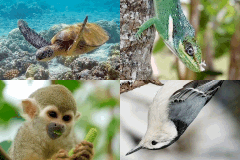AnAge entry for Peromyscus leucopus
Classification (HAGRID: 02550)
- Taxonomy
-
Kingdom: Animalia
Phylum: Chordata
Class: Mammalia (Taxon entry)
Order: Rodentia
Family: Cricetidae
Genus: Peromyscus
- Species
- Peromyscus leucopus
- Common name
- White-footed mouse
- Synonyms
- Hesperomys affinis, Peromyscus arboreus, Hesperomys campestris, Peromyscus canus, Peromyscus cozulmelae, Arvicola emmonsi, Vesperimus mearnsii, Mus michiganensis, Peromyscus musculoides, Cricetus myoides, Hesperomys texana, Peromyscus tornillo, Peromyscus leucopus ammodytes, Peromyscus leucopus aridulus, Sitomys leucopus arizonae, Peromyscus leucopus brevicaudus, Peromyscus texanus castaneus, Peromyscus leucopus caudatus, Peromyscus leucopus easti, Peromyscus texanus flaccidus, Peromyscus leucopus fuscus, Peromyscus leucopus incensus, Peromyscus leucopus lachiguiriensis, Peromyscus texanus mesomelas, Peromyscus leucopus minnesotae, Mus sylvaticus noveboracensis, Peromyscus leucopus ochraceus, Peromyscus leucopus fusus
Lifespan, ageing, and relevant traits
- IMR
- 0.001/year
- MRDT
- 0.5 years
- Maximum longevity
- 7.9 years (captivity)
- Source
- ref. 671
- Sample size
- Small
- Data quality
- Acceptable
- Observations
In the wild, most animals do not live more than 1.5 years. Anecdotal evidence suggests these animals live up to 8.2 years, but this could be the result of confusion with similar species. Record longevity in captivity is 7.9 years [0671].
Life history traits (averages)
- No information is available on life history. Please contact us if you wish to suggest or contribute data.
Metabolism
- Typical body temperature
- 310ºK or 36.7ºC or 98.1ºF
- Basal metabolic rate
- 0.2130 W
- Body mass
- 22.3 g
- Metabolic rate per body mass
- 0.009552 W/g
References
- [1115] Shi et al. (2013), Reduced mitochondrial ROS, enhanced antioxidant defense, and distinct age-related changes in oxidative damage in muscles of long-lived Peromyscus leucopus (PubMed)
- [1143] Nussey et al. (2013), Senescence in natural populations of animals: widespread evidence and its implications for bio-gerontology (PubMed)
- [0917] Ungvari et al. (2008), Testing hypotheses of aging in long-lived mice of the genus Peromyscus: association between longevity and mitochondrial stress resistance, ROS detoxification pathways, and DNA repair efficiency (PubMed)
- [0777] Harper et al. (2007), Skin-derived fibroblasts from long-lived species are resistant to some, but not all, lethal stresses and to the mitochondrial inhibitor rotenone (PubMed)
- [0671] Richard Weigl (2005), Longevity of Mammals in Captivity; from the Living Collections of the World
- [0074] Brunet-Rossinni (2004), Reduced free-radical production and extreme longevity in the little brown bat (Myotis lucifugus) versus two non-flying mammals (PubMed)
- [0036] Savage et al. (2004), The predominance of quarter-power scaling in biology
- [0420] White and Seymour (2003), Mammalian basal metabolic rate is proportional to body mass2/3 (PubMed)
- [0610] Ernest (2003), Life history characteristics of placental non-volant mammals
- [0441] William Burt et al. (1998), A Field Guide to Mammals
- [0304] Duffy et al. (1997), Age and temperature related changes in behavioral and physiological performance in the Peromyscus leucopus mouse (PubMed)
- [0676] Purvis and Harvey (1995), Mammal life-history evolution: a comparative test of Charnov's model
- [0306] Guo et al. (1993), Age- and gender-related variations in the activities of drug-metabolizing and antioxidant enzymes in the white-footed mouse (Peromyscus leucopus) (PubMed)
- [0305] Sohal et al. (1993), Biochemical correlates of longevity in two closely related rodent species (PubMed)
- [0455] Virginia Hayssen et al. (1993), Asdell's Patterns of Mammalian Reproduction: A Compendium of Species-Specific Data
- [0307] Burger and Gochfeld (1992), Survival and reproduction in Peromyscus leucopus in the laboratory: viable model for aging studies (PubMed)
- [0002] Caleb Finch (1990), Longevity, Senescence, and the Genome
- [0542] Bernhard Grzimek (1990), Grzimek's Encyclopedia of Mammals
- [0326] Wilson et al. (1987), Genomic 5-methyldeoxycytidine decreases with age (PubMed)
- [0308] Cohen et al. (1987), Accelerated wound repair in old deer mice (Peromyscus maniculatus) and white-footed mice (Peromyscus leucopus) (PubMed)
- [0680] Wootton (1987), The effects of body mass, phylogeny, habitat, and trophic level on mammalian age at first reproduction
- [0309] Torello et al. (1986), A comparative-evolutionary study of lipids in the aging brain of mice (PubMed)
- [0310] Cutler (1984), Urate and ascorbate: their possible roles as antioxidants in determining longevity of mammalian species (PubMed)
- [0311] Su et al. (1984), Longevity-dependent organ-specific accumulation of DNA damage in two closely related murine species (PubMed)
- [0731] Zullinger et al. (1984), Fitting sigmoid equations to mammalian growth curves
- [0312] Martin et al. (1983), Comparative rates of decline in the primary cloning efficiencies of smooth muscle cells from the aging thoracic aorta of two murine species of contrasting maximum life span potentials (PubMed)
- [0606] Fry et al. (1981), On the activity and fidelity of chromatin-associated hepatic DNA polymerase-beta in aging murine species of different life spans (PubMed)
- [0313] Peluso et al. (1980), Aging and ovarian function in the white-footed mouse (Peromyscus leucopus) with specific reference to the development of preovulatory follicles (PubMed)
- [0314] Steger et al. (1980), Effects of advancing age on the hypothalamic-pituitary-ovarian axis of the female white-footed mouse (Peromyscus leucopus) (PubMed)
- [0436] Cutler (1979), Evolution of human longevity: a critical overview (PubMed)
- [0315] Hart et al. (1979), Longevity, stability and DNA repair (PubMed)
- [0534] Sacher and Hart (1978), Longevity, aging and comparative cellular and molecular biology of the house mouse, Mus musculus, and the white-footed mouse, Peromyscus leucopus (PubMed)
- [0773] PeroBase
External Resources
- Integrated Taxonomic Information System
- ITIS 180278
- Animal Diversity Web
- ADW account
- Encyclopaedia of Life
- Search EOL
- NCBI Taxonomy
- Taxonomy ID 10041
- Entrez
- Search all databases
- Ageing Literature
- Search Google Scholar or Search PubMed
- Images
- Google Image search
- Internet
- Search Google

